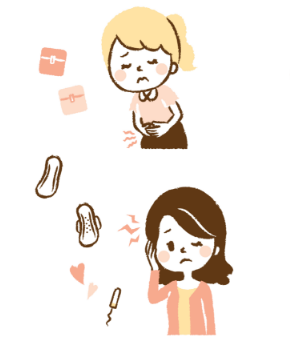The Ins and Outs of PMS Anxiety


PMS affects a large majority individuals, with many experiencing mood swings in the days leading up to menstruation. While most of them deal with PMS symptoms including irritation, rage, and mood changes on a monthly basis, severe premenstrual symptoms can be emotionally devastating. Fortunately, it is not difficult to control mood swings and other emotional issues by managing PMS symptoms with medication and lifestyle adjustments. Some people experience violent, uncontrollable mood swings as a result of PMS, going from sobbing episodes to angry outbursts and anxiety attacks, then returning to a stable emotional state — all in the same day.
A roller coaster of emotions, PMS is a set of mental and physical symptoms that people experience during the luteal phase, which occurs after ovulation. After ovulation, the luteal phase begins and normally lasts 14 days, ending when you get your period. PMS anxiety, which is a symptom of the premenstrual syndrome, can manifest itself in a variety of ways, including uneasiness, tension, and excessive worry. During this time, a lot of people experience mild-to-moderate mood swings. In case of severe symptoms, it can indicate PMDD, a premenstrual dysphoric disorder.
Why Does it Happen
Premenstrual syndrome reasons are not completely understood by experts. However, the majority of people believe that PMS symptoms, such as anxiety, are caused by changes in estrogen and progesterone levels. During the luteal phase of menstruation, the levels of these reproductive hormones rise and fall drastically. After ovulation, your body begins to prepare for pregnancy by increasing hormone production. If an egg does not implant, hormone levels drop, and the period begins.
This hormonal rollercoaster might disrupt neurotransmitters in your brain that regulate your mood, such as serotonin and dopamine. This could explain some of the psychological symptoms associated with PMS, such as anxiety, despair, and mood swings.
PMDD

PMDD is a mood condition that affects majority of menstruating individuals. PMDD is linked to the presence of other mental health issues. You may be at higher risk if you have a personal or family history of anxiety or depression.
Some of the PMDD symptoms are as below.
- Feelings of irritability or anger that frequently affect relationships
- Feelings of sadness, hopelessness, or despair
- Tension or anxiety
- Feeling on edge or keyed up
- Mood swings or frequent crying
- Decreased interest in activities or relationships
- Trouble thinking or focusing
- Tiredness or low energy
- Food cravings or binge eating
- Trouble sleeping
PME

PMDD and PME are closely connected. It occurs when a preexisting ailment, such as generalised anxiety disorder, worsens during your cycle's luteal phase.
Depression, anxiety disorders, migraines, seizures, eating disorders, and schizophrenia are all preexisting diseases that might flare up before your period.
The distinction between PMDD and PME is that PME patients have symptoms throughout the month, and they only get worse in the weeks leading up to their period.
Dealing With PMS Anxiety
There are several things you may take to reduce premenstrual anxiety and other PMS symptoms, the majority of them include lifestyle and dietary modifications. Knowing that your anxiety is linked to your menstrual cycle will help you prepare to deal with your PMS symptoms when they come.
Exercise - Studies show that those who workout regularly throughout the month, experience fewer severe PMS symptoms. Regular exercise has a lower risk of mood and behaviour disturbances, such as anxiety, depression, and difficulty concentrating, than the general population. Exercising can also help alleviate uncomfortable bodily sensations.
Relaxation - Relaxation techniques for stress reduction may aid in the management of premenstrual anxiety. Yoga, meditation, and massage therapy are examples of common techniques.
Diet - Consuming carbohydrates constitutes part of PMS treatment. During PMS, a diet high in complex carbohydrates, such as whole grains and starchy vegetables, can help alleviate moodiness and anxiety-inducing food cravings. Calcium-rich foods, such as yoghurt and milk, may also be beneficial.
Vitamins - Calcium and vitamin B-6 have both been shown in studies to help with the physical and psychological symptoms of the premenstrual syndrome.
Sleep – Adequate sleep is essential to keep your mind and body calm, and help it rejuvenate. Early to bed and early to rise is an effective remedy to dealing with PMS anxiety and premenstrual stress, considering it ensures a fresh mind all day long.
Things to Avoid – Certain things are known to trigger PMS symptoms. In the week prior to your period, try and steer clear of alcohol, caffeine, fatty foods, excess salt and sugar.
Is It Normal?

Owing to the hormonal changes in the body during the different phases of the menstrual cycle, it is normal for some individuals to experience PMS anxiety. Most will go through mood swings, irritability, and crying spells, but anxiety is something a small population will go through anxiety. If it significantly affects your daily life, it is worth seeing your doctor.





